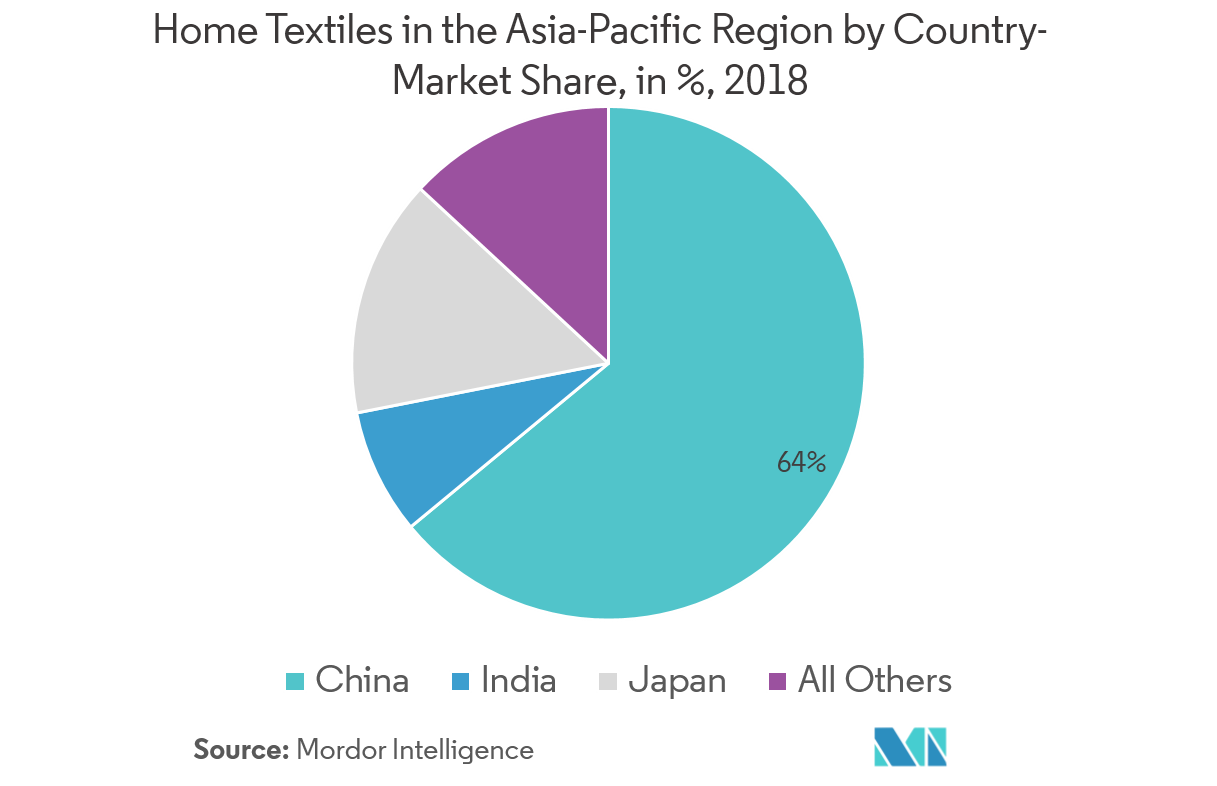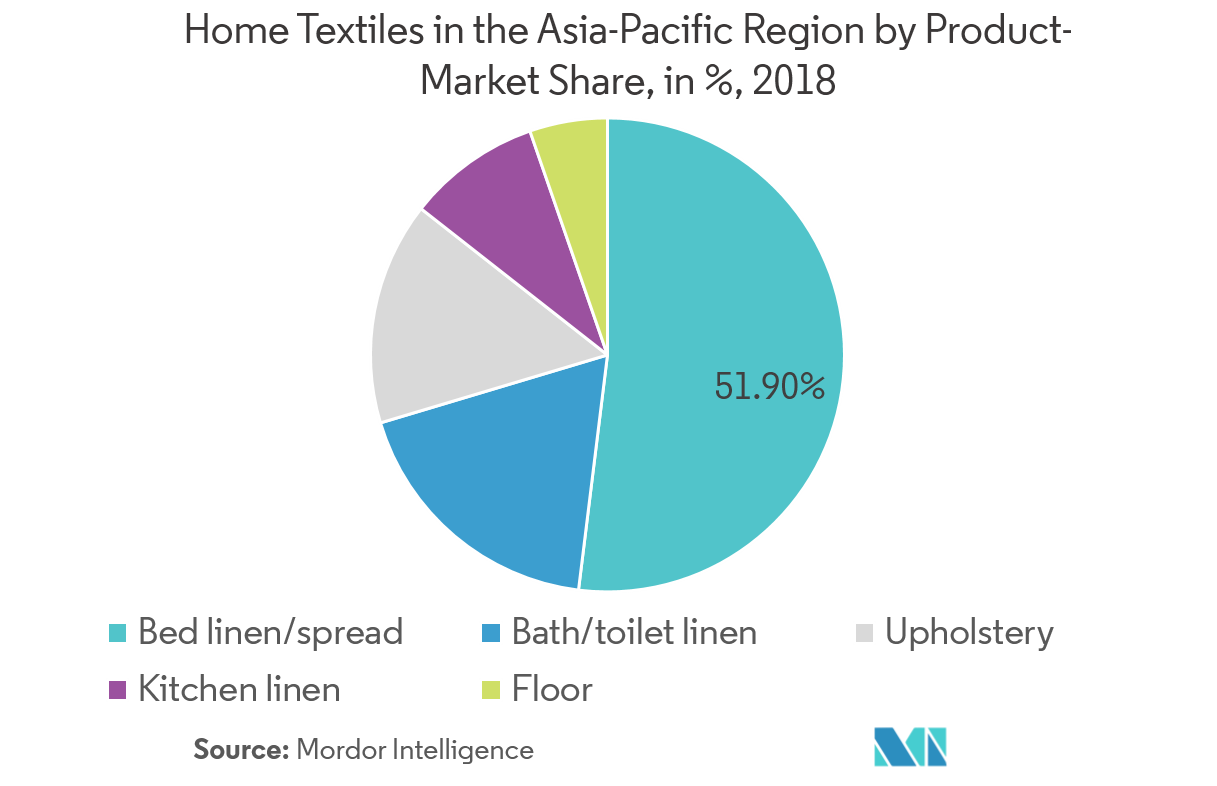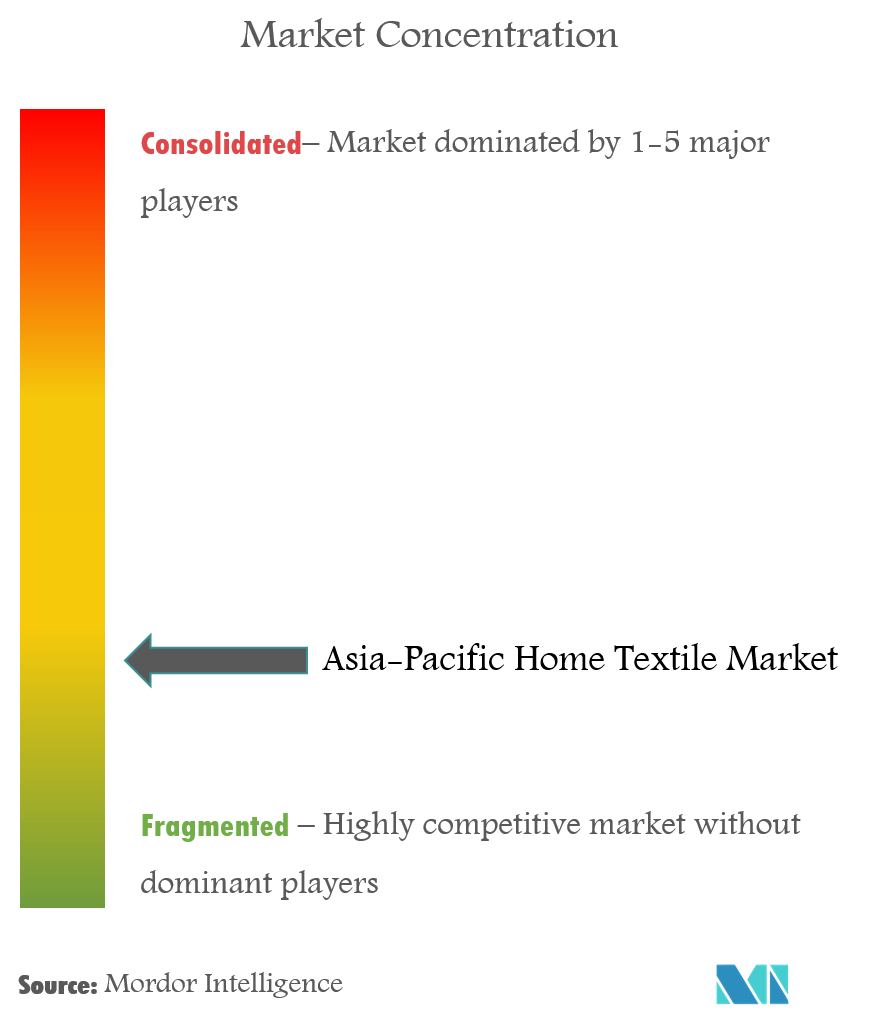APAC Home Textile Market Size

| Study Period | 2020 - 2029 |
| Base Year For Estimation | 2023 |
| Forecast Data Period | 2024 - 2029 |
| Historical Data Period | 2020 - 2022 |
| CAGR | 5.30 % |
Major Players
*Disclaimer: Major Players sorted in no particular order |
Need a report that reflects how COVID-19 has impacted this market and its growth?
APAC Home Textile Market Analysis
Asia-Pacific accounts for approximately 60% of the global populations and dominant production of home textiles product region and is also a leader in the consumption of home textiles products.
- China is the largest manufacturer and consumer of home textiles. India is the third largest home textiles market in the Asia-Pacific region.
- Factors, such asthe housing boom in Asia-Pacific, increasing fashion trends in home textiles, and demand recovery from Western economies, aredriving the growth of home textiles globally.
- Key factors driving the robust growth rate of Asia-Pacific region include surging per capita expenditure, availability of potential consumers in the market, increasing investments by major regional players, improving lifestyles of consumers. These factorsare also driving the demand for home textile in the market.
- India is the third largest country in the market. The growth in the Indian home textiles is supported by the growing household income, increasing population, rising income levels, increase in organized retail and growth of end-use sectors, like housing, hospitality, and healthcare.
APAC Home Textile Market Trends
This section covers the major market trends shaping the APAC Home Textile Market according to our research experts:
China Accounts for a Major Percentage of the Market Share in the Region
China’s huge population, coupled with its increasing textile and clothing consumption per capita year by year, provides a lucrative global business opportunity. China’s huge population, coupled with its increasing textile and clothing consumption per capita year by year, provides lucrative opportunities for global business. The top goods exported to China consist mainly of fiber and yarns. Guangdong Province, Shanghai, Nantong in Jiangsu Province, Zhejiang Province, and Shandong Province are the industrial cluster areas in China. Major raw materials of the home textile industry include cotton, chemical fiber, accessories, etc.

Bed Linen Segment is the Largest
Bed linen which covers home textiles products such as bed covering, bed throws, blankets, cushion covers, cushions, duvets, duvet covers, mattress, mattress cover, pillows and many more represents the largest segment in the home textiles market. This segment is the fastest growing in the region with a significant growth rate. Growth in the hospitality industry, increased spending in emerging economies are some of the major factors responsible for growth in the segment in recent time and the trend is expected to continue in the near future.

APAC Home Textile Industry Overview
The report covers major international players operating in the Asia-Pacific home textile market. In terms of market share, few of the major players currently dominate the market. However, demand is driven by consumer income. Large companies compete through volume purchasing, breadth of products, and effective merchandising and marketing. Small companies focus on a market segment and compete through the depth of products and superior customer service.
APAC Home Textile Market Leaders
Welspun Group
Sunvim Group Co. Ltd
Luolai Home Textile Co. Ltd
Bombay Dyeing
Fuanna
*Disclaimer: Major Players sorted in no particular order

APAC Home Textile Market Report - Table of Contents
-
1. INTRODUCTION
-
1.1 Key Deliverables of the Study
-
1.2 Study Assumptions
-
1.3 Scope of the Study
-
-
2. RESEARCH METHODOLOGY
-
3. EXECUTIVE SUMMARY
-
4. MARKET INSIGHTS AND DYNAMICS
-
4.1 Market Overview
-
4.2 Drivers
-
4.3 Restraints
-
4.4 Opportunities
-
4.5 Challenges
-
4.6 Trends Influencing the Asia-Pacific Home Textile Market
-
4.7 Value Chain Analysis of the Asia-Pacific Home Textile Market
-
4.8 Porter's Five Forces Analysis
-
4.9 Technological Innovations
-
-
5. MARKET SEGMENTATION
-
5.1 By Product
-
5.1.1 Bed Linen
-
5.1.2 Bath Linen
-
5.1.3 Kitchen Linen
-
5.1.4 Upholstery
-
5.1.5 Floor
-
-
5.2 By End User
-
5.2.1 Residential
-
5.2.2 Commercial
-
5.2.3 Hospitality & Leisure
-
5.2.4 Offices
-
5.2.5 Hospitals
-
5.2.6 Others
-
-
5.3 By Distribution Channel
-
5.3.1 Supermarkets & Hypermarkets
-
5.3.2 Specialty Stores
-
5.3.3 Online
-
5.3.4 Others
-
-
5.4 By Country
-
5.4.1 China
-
5.4.2 Japan
-
5.4.3 India
-
5.4.4 Others
-
-
-
6. COMPANY PROFILES
-
6.1 Welspun Group
-
6.2 Sunvim Group Co Ltd
-
6.3 Luolai Lifestyle Technology Co. Ltd
-
6.4 Bombay Dyeing
-
6.5 Fuanna
-
6.6 Hunan Mendale Hometextile Co.,Ltd
-
6.7 Shanghai Shuixing Home Textile Co., Ltd.
-
6.8 Arvind Ltd
-
6.9 Raymond Group
-
6.10 Trident Limited*
-
- *List Not Exhaustive
-
7. FUTURE OF THE ASIA-PACIFIC HOME TEXTILE MARKET
-
8. APPENDIX
APAC Home Textile Industry Segmentation
A complete background analysis of the Asia-Pacific home textile market, which includes an assessment of the economy and contribution of sectors in the economy, market overview, market size estimation for key segments, and emerging trends in the market segments, market dynamics, and logistics spending by the end-user industries, is covered in the report.
| By Product | |
| Bed Linen | |
| Bath Linen | |
| Kitchen Linen | |
| Upholstery | |
| Floor |
| By End User | |
| Residential | |
| Commercial | |
| Hospitality & Leisure | |
| Offices | |
| Hospitals | |
| Others |
| By Distribution Channel | |
| Supermarkets & Hypermarkets | |
| Specialty Stores | |
| Online | |
| Others |
| By Country | |
| China | |
| Japan | |
| India | |
| Others |
APAC Home Textile Market Research FAQs
What is the current Asia-Pacific Home Textile Market size?
The Asia-Pacific Home Textile Market is projected to register a CAGR of 5.30% during the forecast period (2024-2029)
Who are the key players in Asia-Pacific Home Textile Market?
Welspun Group, Sunvim Group Co. Ltd, Luolai Home Textile Co. Ltd, Bombay Dyeing and Fuanna are the major companies operating in the Asia-Pacific Home Textile Market.
What years does this Asia-Pacific Home Textile Market cover?
The report covers the Asia-Pacific Home Textile Market historical market size for years: 2020, 2021, 2022 and 2023. The report also forecasts the Asia-Pacific Home Textile Market size for years: 2024, 2025, 2026, 2027, 2028 and 2029.
APAC Home Textiles Industry Report
Statistics for the 2024 APAC Home Textiles market share, size and revenue growth rate, created by Mordor Intelligence™ Industry Reports. APAC Home Textiles analysis includes a market forecast outlook 2029 and historical overview. Get a sample of this industry analysis as a free report PDF download.
